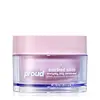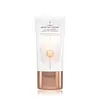What's inside
What's inside
 Key Ingredients
Key Ingredients

 Benefits
Benefits

 Concerns
Concerns

 Ingredients Side-by-side
Ingredients Side-by-side

Water
Skin ConditioningGlycerin
HumectantCyclopentasiloxane
EmollientButylene Glycol
HumectantDimethicone
EmollientSodium Chloride
MaskingDimethicone Crosspolymer
Emulsion StabilisingPhenoxyethanol
PreservativePEG/PPG-18/18 Dimethicone
EmulsifyingCetyl PEG/PPG-10/1 Dimethicone
EmulsifyingChlorphenesin
AntimicrobialRosa Damascena Flower Water
MaskingParfum
MaskingPentylene Glycol
Skin ConditioningBiosaccharide Gum-1
HumectantSodium Acetylated Hyaluronate
HumectantSodium Hyaluronate
HumectantSodium Hyaluronate Crosspolymer
HumectantHydrolyzed Sodium Hyaluronate
Skin ConditioningEthylhexylglycerin
Skin ConditioningBenzyl Salicylate
PerfumingCI 14700
Cosmetic ColorantWater, Glycerin, Cyclopentasiloxane, Butylene Glycol, Dimethicone, Sodium Chloride, Dimethicone Crosspolymer, Phenoxyethanol, PEG/PPG-18/18 Dimethicone, Cetyl PEG/PPG-10/1 Dimethicone, Chlorphenesin, Rosa Damascena Flower Water, Parfum, Pentylene Glycol, Biosaccharide Gum-1, Sodium Acetylated Hyaluronate, Sodium Hyaluronate, Sodium Hyaluronate Crosspolymer, Hydrolyzed Sodium Hyaluronate, Ethylhexylglycerin, Benzyl Salicylate, CI 14700
Water
Skin ConditioningCyclopentasiloxane
EmollientDimethicone
EmollientPhenylpropyldimethylsiloxysilicate
EmollientDiisostearyl Malate
EmollientButylene Glycol
HumectantCI 77891
Cosmetic ColorantCI 77163
Cosmetic ColorantSodium Chloride
MaskingPEG/PPG-18/18 Dimethicone
EmulsifyingGlycerin
HumectantCyclohexasiloxane
EmollientAluminum/Magnesium Hydroxide Stearate
Emulsion StabilisingDimethicone/PEG-10/15 Crosspolymer
CI 77492
Cosmetic ColorantCellulose Acetate
Dimethiconol
EmollientDisodium Cocoyl Glutamate
CleansingCI 77491
Cosmetic ColorantParfum
MaskingMethylparaben
PreservativePotassium Sorbate
PreservativeSilica Dimethyl Silylate
EmollientAcrylates/Ammonium Methacrylate Copolymer
Propylene Glycol Stearate
Skin ConditioningTocopheryl Acetate
AntioxidantUrea
BufferingPropylparaben
PreservativeCI 77499
Cosmetic ColorantSodium Cocoyl Glutamate
CleansingMagnesium Stearate
Cosmetic ColorantSaccharide Hydrolysate
HumectantAlanine
MaskingGlycine
BufferingMagnesium Aspartate
Skin ConditioningDipropylene Glycol
HumectantPhenoxyethanol
PreservativeBenzyl Alcohol
PerfumingSodium Citrate
BufferingCreatine
Skin ConditioningPolysilicone-11
Dehydroacetic Acid
PreservativeTocopherol
AntioxidantWater, Cyclopentasiloxane, Dimethicone, Phenylpropyldimethylsiloxysilicate, Diisostearyl Malate, Butylene Glycol, CI 77891, CI 77163, Sodium Chloride, PEG/PPG-18/18 Dimethicone, Glycerin, Cyclohexasiloxane, Aluminum/Magnesium Hydroxide Stearate, Dimethicone/PEG-10/15 Crosspolymer, CI 77492, Cellulose Acetate, Dimethiconol, Disodium Cocoyl Glutamate, CI 77491, Parfum, Methylparaben, Potassium Sorbate, Silica Dimethyl Silylate, Acrylates/Ammonium Methacrylate Copolymer, Propylene Glycol Stearate, Tocopheryl Acetate, Urea, Propylparaben, CI 77499, Sodium Cocoyl Glutamate, Magnesium Stearate, Saccharide Hydrolysate, Alanine, Glycine, Magnesium Aspartate, Dipropylene Glycol, Phenoxyethanol, Benzyl Alcohol, Sodium Citrate, Creatine, Polysilicone-11, Dehydroacetic Acid, Tocopherol
Ingredients Explained
These ingredients are found in both products.
Ingredients higher up in an ingredient list are typically present in a larger amount.
Butylene Glycol (or BG) is used within cosmetic products for a few different reasons:
Overall, Butylene Glycol is a safe and well-rounded ingredient that works well with other ingredients.
Though this ingredient works well with most skin types, some people with sensitive skin may experience a reaction such as allergic rashes, closed comedones, or itchiness.
Learn more about Butylene GlycolCyclopentasiloxane, or D5, is a silicone used to improve texture of products and trap moisture.
D5 is considered lightweight and volatile. Volatile means it evaporates quickly after application. Once evaporated, D5 leaves a thin barrier that helps keep skin hydrated.
It is also an emollient. Emollients help soften the skin and prevent water loss. Silicones create a silky texture in products. D5 helps other ingredients become more spreadable.
Studies show D5 is safe to use in skincare products. We recommend speaking with a skincare professional if you have concerns.
Learn more about CyclopentasiloxaneDimethicone is a type of synthetic silicone created from natural materials such as quartz.
What it does:
Dimethicone comes in different viscosities:
Depending on the viscosity, dimethicone has different properties.
Ingredients lists don't always show which type is used, so we recommend reaching out to the brand if you have questions about the viscosity.
This ingredient is unlikely to cause irritation because it does not get absorbed into skin. However, people with silicone allergies should be careful about using this ingredient.
Note: Dimethicone may contribute to pilling. This is because it is not oil or water soluble, so pilling may occur when layered with products. When mixed with heavy oils in a formula, the outcome is also quite greasy.
Learn more about DimethiconeGlycerin is already naturally found in your skin. It helps moisturize and protect your skin.
A study from 2016 found glycerin to be more effective as a humectant than AHAs and hyaluronic acid.
As a humectant, it helps the skin stay hydrated by pulling moisture to your skin. The low molecular weight of glycerin allows it to pull moisture into the deeper layers of your skin.
Hydrated skin improves your skin barrier; Your skin barrier helps protect against irritants and bacteria.
Glycerin has also been found to have antimicrobial and antiviral properties. Due to these properties, glycerin is often used in wound and burn treatments.
In cosmetics, glycerin is usually derived from plants such as soybean or palm. However, it can also be sourced from animals, such as tallow or animal fat.
This ingredient is organic, colorless, odorless, and non-toxic.
Glycerin is the name for this ingredient in American English. British English uses Glycerol/Glycerine.
Learn more about GlycerinParfum is a catch-all term for an ingredient or more that is used to give a scent to products.
Also called "fragrance", this ingredient can be a blend of hundreds of chemicals or plant oils. This means every product with "fragrance" or "parfum" in the ingredients list is a different mixture.
For instance, Habanolide is a proprietary trade name for a specific aroma chemical. When used as a fragrance ingredient in cosmetics, most aroma chemicals fall under the broad labeling category of “FRAGRANCE” or “PARFUM” according to EU and US regulations.
The term 'parfum' or 'fragrance' is not regulated in many countries. In many cases, it is up to the brand to define this term.
For instance, many brands choose to label themselves as "fragrance-free" because they are not using synthetic fragrances. However, their products may still contain ingredients such as essential oils that are considered a fragrance by INCI standards.
One example is Calendula flower extract. Calendula is an essential oil that still imparts a scent or 'fragrance'.
Depending on the blend, the ingredients in the mixture can cause allergies and sensitivities on the skin. Some ingredients that are known EU allergens include linalool and citronellol.
Parfum can also be used to mask or cover an unpleasant scent.
The bottom line is: not all fragrances/parfum/ingredients are created equally. If you are worried about fragrances, we recommend taking a closer look at an ingredient. And of course, we always recommend speaking with a professional.
Learn more about ParfumPEG/PPG-18/18 Dimethicone is a type of silicone.
Phenoxyethanol is a preservative that has germicide, antimicrobial, and aromatic properties. Studies show that phenoxyethanol can prevent microbial growth. By itself, it has a scent that is similar to that of a rose.
It's often used in formulations along with Caprylyl Glycol to preserve the shelf life of products.
Chances are, you eat sodium chloride every day. Sodium Chloride is also known as table salt.
This ingredient has many purposes in skincare: thickener, emulsifier, and exfoliator.
You'll most likely find this ingredient in cleansers where it is used to create a gel-like texture. As an emulsifier, it also prevents ingredients from separating.
There is much debate on whether this ingredient is comedogenic. The short answer - comedogenic ratings don't tell the whole story. Learn more about comegodenic ratings here.
The concensus about this ingredient causing acne seems to be divided. Research is needed to understand if this ingredient does cause acne.
Scrubs may use salt as the primary exfoliating ingredient.
Learn more about Sodium ChlorideWater. It's the most common cosmetic ingredient of all. You'll usually see it at the top of ingredient lists, meaning that it makes up the largest part of the product.
So why is it so popular? Water most often acts as a solvent - this means that it helps dissolve other ingredients into the formulation.
You'll also recognize water as that liquid we all need to stay alive. If you see this, drink a glass of water. Stay hydrated!
Learn more about Water